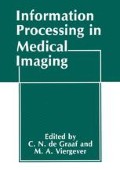Abstract
Non-stationary deconvolution is of considerable importance is several areas of medical image processing. Quantitative errors occur in tomography as a result of the partial volume effect which has two components; the loss of ‘recovery’ due to the object being incomplete within the slice thickness, and loss due to sampling observed when the object is comparable in size to the resolution of the system. In SPECT, this second problem, in particular, is non-stationary since the resolution of the detecting system is a function of distance from the detector. This paper described a method for attacking such problems using a multi-resolution stack. A filter is chosen which generates successively the images of a multi-resolution stack, by successive blurring with a Gaussian filter function. The filter function chosen for this purpose should be a smoothing filter with only a slight blurring effect such that the sampling in the ‘blurred direction’ is reasonably fine. Prior to smoothing, a deconvolution filter is used, matched with the Gaussian blurring filters to give the range of deconvolutions required for different positions. Thus, after an initial stationary deconvolution a series of progressively smoother versions of this image are stored in a stack (S). The desired non-stationary filtered image can be shown to be an intersection of some given surface within the processed stack. In the case of the SPECT sampling problem, this intersection take the form of a simple radially symmetrical bowl shaped surface. The coordinates of this surface may be calculated in advance in terms of determining a k (scale space) coordinate in the processed stack corresponding each i, j coordinate in the original image. The third stage of the filtering operation is that of projecting this intersecting surface down to give a processed image I’, such that I’(i,j)=S(i,j,k), where (i,j,k) is a point on the surface within the stack. In most cases this may be performed while only remembering one level of the stack at a time. The whole process then becomes highly efficient, and requires little storage space, being merely n times a compact linear filtering operation where n depends on the scale sampling chosen. It may be demonstrated that small values of n can be used with little distortion of the resulting image. Preliminary results, which could be of value in other types of tomographic instrumentation, have confirmed that such a technique can aid in eliminating non-stationary partial volume effects.
Access this chapter
Tax calculation will be finalised at checkout
Purchases are for personal use only
Preview
Unable to display preview. Download preview PDF.
References
B. Axelsson, P. Masaki and A. Israelsson, (1984), Subtraction of Compton-scattered photons in single photon emission computerized tomography, J. Nucl. Med. 25: 490–494.
V. Bettinardi, M.C. Gilardi, C. Pantalone, A. Todd-Pokropek, P. Gerundini and F. Fazio, (1986), Scatter correction techniques in SPECT, in “Proceedings. of the S.N.M.E. Annual Meeting”, Goslar.
C.E. Floyd, R.J. Jaszczak and R.E. Coleman,(1984), Inverse Monte Carlo: a unified reconstruction algorithm for SPECT, IEEE Trans. Nucl. Sci. NS-32:779–785.
R.J. Jaszczak, K.L. Greer, C.E. Floyd, Jr., C.C. Harris and R.E. Coleman, (1984), Improved SPECT quantification using compensation for scattered photons, J. Nucl. Med. 25: 893–900.
J.J. Koenderink,(1984), The structure of images, Biol. Cybern. 50: 363–370.
K.F. Koral, S. Buchbinder, N.H. Clinthorne, W.L. Rogers, B.M.W. Tsui and E.R. Edgerton, (1987), Compensation for attenuation and Compton-scattering in absolute quantification of tumor activity, J. Nucl. Med. 28: 577.
E.J. Hoffman, S-C. Huang, M.E. Phelps et al. (1979), Quantitation in positron emission computer tomography: 1. Effect of object size, J. Comput. Assist. Tomoqr. 3: 299–308.
S.C. Moore, M.F. Kijewski, S.P. Mueller and B.L. Holman,(1987), The noise power spectrum for SPECT: effects of non-stationary projection noise and attenuation correction, J. Nucl. Med. 28: 630.
F. Natterer, (1986), “The mathematics of computerized tomography”, Wiley, Stuttgart.
O. Ying Lee, (1983), An ECAT reconstruction method which corrects for attenuation and detector response, IEEE Trans. Nucl. Sci. NS-30: 632–635.
O. Ying Lee, (1985), The mathematics and physics of computerized tomography. PhD Thesis, University of Delft.
A. Todd-Pokropek, G. Clarke, R. Marsh, (1984), Preprocessing of SPECT data as a precursor for attenuation correction, in “Information processing in medical imaging”, F. Deconinck ed, Martinus Nijhoff, Boston, 130–150.
B.R. Zeeberg, A.N. Bice, S. Loncaric, H.N. Wagner and R.C, Reba, (1987), A theoretically-correct algorithm to compensate for a three-dimensional spatially-variant point spread function ion SPECT imaging, J. Nucl. Med. 28: 662.
Author information
Authors and Affiliations
Editor information
Editors and Affiliations
Rights and permissions
Copyright information
© 1988 Springer Science+Business Media New York
About this chapter
Cite this chapter
Todd-Pokropek, A. (1988). Non-Stationary Deconvolution Using a Multi-Resolution Stack. In: de Graaf, C.N., Viergever, M.A. (eds) Information Processing in Medical Imaging. Springer, Boston, MA. https://doi.org/10.1007/978-1-4615-7263-3_18
Download citation
DOI: https://doi.org/10.1007/978-1-4615-7263-3_18
Publisher Name: Springer, Boston, MA
Print ISBN: 978-1-4615-7265-7
Online ISBN: 978-1-4615-7263-3
eBook Packages: Springer Book Archive

